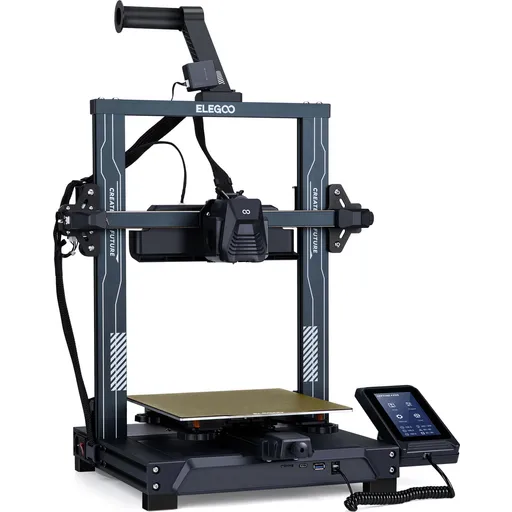Compare KP3S PRO V2 vs Neptune 4 PRO
Comparison between the best 3D printers
Choose the best 3D printer at the best price. The cheapest 3D printers are here.
Buy a 3D printer here with 3D Fila.
 |
 |
|
| Model | KP3S PRO V2 |
Neptune 4 PRO |
| Printing Material | Filament | Filament |
| Buy Filament for Kingroon KP3S PRO V2 | Buy Filament forElegoo Neptune 4 PRO | |
| Estimated price | $229,00 | $359,00 |
| Manufacturer | Kingroon | Elegoo |
| Release Year | 2024 | 2023 |
| Print Volume [mm] | 220x220x250 | 225x225x265 |
| Printer Size [mm] | 420x400x450 | 475x445x515 |
| Weight [kg] | 12,6 | 8,9 |
| Power Loss Recovery | NO | YES |
| Enclosed printer | NO | NO |
| Bed Leveling | Automatic | Automatic |
| Filament End Sensor | NO | YES |
| Bed type | Heated | Heated |
| Power supply system | Direct Drive | Direct Drive |
| Standard nozzle | 0,4 | 0,4 |
| Maximum Nozzle Temperature [°C] | 260 | 300 |
| Maximum Bed Temperature [°C] | 100 | 110 |
| Maximum printing speed [mm/s] | 350 | 500 |
| Filament holder | YES | YES |
| Camera for supervision | NO | NO |
| Recommended filaments | PLA, PETG, TPU | PLA, PLA+, TPU, PETG, Nylon, ABS |
| Recommended slicers | Cura, Orca Slicer | Bambu Studio, Super Slicer, Cura, Prusa Slicer, Orca |
| Maximum Resolution [mm] | 0,01 | 0,1 |
| Processor | ARM 64 bit | |
| Display | LCD Mono | Touchscreen 4,3'' |
| Power Supply | 300 W | 310 W |
| Connectivity | USB-C / MicroSD / Ethernet | USB, microSD |
| Operating systems | Windows, Mac, Linux | Windows, Linux, Macbook |
| Date of registration in the system | 2025-03-18 | 2024-07-02 |
| Release date | 2024 | 2023 |
| Extra features | The Kingroon KP3S Pro V2 is a high-speed FDM 3D printer with Klipper firmware, ensuring fast and precise prints. It features linear rails on all axes, a Direct Drive extruder with a 9.5:1 gear ratio, and an efficient ceramic heater. It includes an inductive sensor for automatic bed leveling, a PEI magnetic bed, a built-in accelerometer for vibration calibration, and Wi-Fi, Ethernet, and USB connectivity for remote control. | The Elegoo Neptune 4 Pro stands out for its advanced features, including pre-installed Klipper firmware, a dual-gear direct extruder with a 5.2:1 ratio, a high-temperature nozzle (up to 300°C), a flexible magnetic PEI platform, efficient cooling fans, and a 121-point auto-leveling system. The printer also features a 4.3-inch touchscreen interface, dual linear bars on the X and Y axes, and a segmented heated bed for energy savings. |
| Support for multiple colors and materials (AMS and CFS) | NO | NO |
Notes * |
||
| Cost-benefit | 7 / 10 | 7 / 10 |
| Hardware | 0.8 / 10 | 2.8 / 10 |
| Tela | . | . |
| Print volume | 3 / 10 | 3 / 10 |
| Performance | 3 / 10 | 4 / 10 |
Conclusion |
| In comparing the Kingroon KP3S Pro V2 and the Elegoo Neptune 4 Pro, both 3D printers cater to different user preferences and budgets while sharing some core features that make them viable options for various printing projects. The KP3S Pro V2 is positioned as a more affordable choice, offering solid performance with its direct drive system and automatic bed leveling. It has a commendable print speed and a maximum resolution that makes it suitable for hobbyists looking for fast and precise fabrications. However, it lacks some advanced safety features like power loss recovery and filament end sensors, which may concern users who prioritize reliability during longer print jobs. Conversely, the Neptune 4 Pro, though it comes at a higher price, includes several advanced upgrades that enhance its usability. These include a high-temperature nozzle suitable for a wider range of materials, an advanced auto-leveling system, and a more intuitive touchscreen interface. Its slightly larger print volume and additional safety features provide peace of mind, particularly for users looking to explore more complex prints with varied materials. Ultimately, choosing between these two models boils down to specific needs and budget constraints. The KP3S Pro V2 may be ideal for entry-level users or those who are more budget-conscious, while the Neptune 4 Pro may appeal to more experienced users seeking advanced features and greater material flexibility. Both printers offer good value within their respective price points, making them commendable choices in the 3D printing landscape. |

